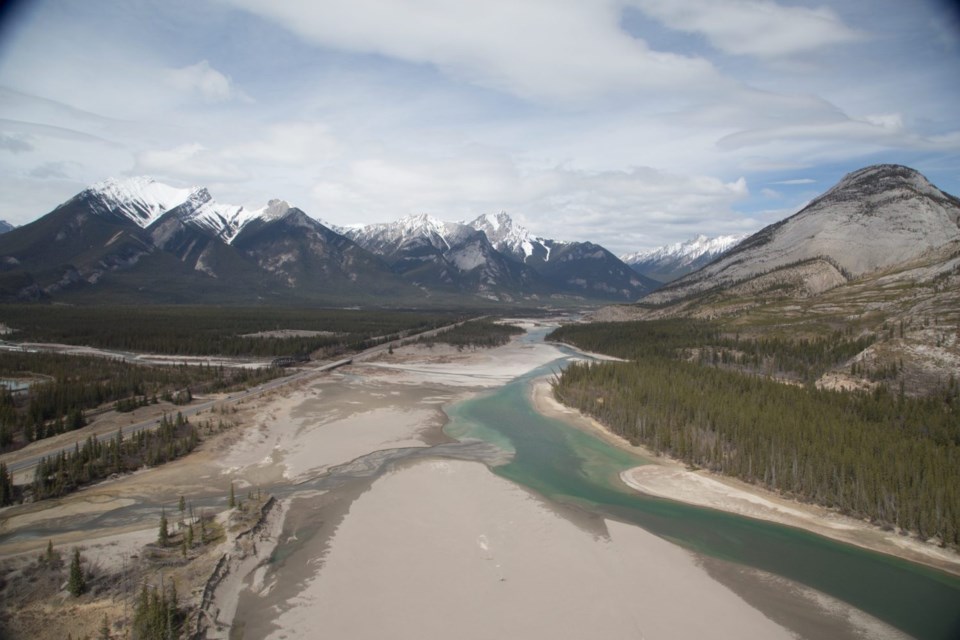The agreement established their mutual commitment to share resources by means of reciprocal hunting privileges within each other's respective hunting grounds on the land now known as Jasper National Park.
"This is just a reawakening to show the other user groups in Jasper that it is a shared area: that we're working together on continuing ensuring it's a shared area," said Kúkwpi7 (Chief) for Simpcw George Lampreau.
"We didn't do this overnight. It's been a long, long process," said Barry Wesley of the Stoney Nation.
Since time immemorial, the two nations have had a treaty and their ancestors would reconnect the treaty within the eastern slopes every four years up until Jasper National Park was established in 1907, then called Jasper Forest Park.
With the involvement of the Indigenous Working Group that was formed in 2005, efforts were made to reestablish traditional Indigenous practices. So far, they have been allowed to harvest medicines and reconnect to the mountains for healing.
"We've done that, and then the only thing that was missing was harvesting the food," Wesley said.
Discussions to renew the harvest as a shared practice have been ongoing since 2017. This harvest will take place starting next week.
It is an important moment for the two Nations as it signals their longstanding interest in positive relations around the territory with co-operation involving both external and internal boundaries.
This harvest will also occur in the month that marks the first anniversary of Kúkwpi7 Lampreau's time as chief of the Símpcwemc (the proper name for the Simpcw people).
"When we come to do business together, we have something in place that guides us," he said, adding that this will also serve as a teaching moment for the general public to learn more about the past and what Indigenous rights they still have.
"For us internally between our nations, this is a form of reconciliation, because reconciliation implies two sides coming together to make the past wrongs right. For us in Simpcw First Nation, the past wrong was the government kicking us out of Jasper, removing all of us from our homelands and breaking those ties we had through these protocols and sharing agreements."
Mark Young, Indigenous relations and cultural heritage manager within Jasper National Park, explained that the 1982 Constitution Act entrenched Indigenous treaty rights.
"What you often saw when parks and marine conservation areas were created in Canada, it often incorporated Indigenous harvesting in the concept of ecological integrity,” Young said.
“What that did was it shone a light on what ecological integrity was defined in Parks created prior to 1982, and this is one such park: Jasper."
When Jasper National Park was created, the Indigenous people were removed, and their traditional practices of land stewardship went with them. Kúkwpi7 Lampreau said that the caribou would have not been endangered and need special measures like the caribou conservation breeding facility to re-establish their herds.
"What we've been trying to do . . . is address that, and, where possible, work with Indigenous partners to sustainably bring back practices,” Young said.
“In this case, in this particular practice, it's a fauna harvest. In terms of the agency, that's the direction we're going forward with, especially as it relates to how we implement the United Nations Declaration on the Rights of Indigenous Peoples Act."
“Facilitating this harvest is just one way we’re supporting the Simpcw First Nation and Stoney Nation to reconnect to their territories," said Jasper Field Unit Superintendent Alan Fehr in a prepared statement.
Fehr explained in the statement that conservation and safety are shared goals for both Parks Canada and Indigenous partners.
"We’re working with Indigenous governments and communities to reintegrate practices like harvesting in alignment with shared conservation objectives. Harvesting as an Indigenous practice is an inherent responsibility tied to caring for and stewarding the lands, waters and ice. It will contribute to the success of initiatives related to conservation and cultural heritage.”
Wesley said it was a relief and an excitement between the generations, as well as educational for their youth as well.
“Some of our young people didn't know the treaty existed. Also, the elders are very excited to come and conduct the pipe ceremony for the next generation. Some of our political leaders are preparing for a sacred ceremony."
"That's our intent to reawaken this: they're going to bring their pipe carriers and we're going to bring our pipe carriers. We're going to look at having a pipe ceremony, because that's the way we like to ensure our activities are grounded and be starting out in a good way is through these ceremonies," Kúkwpi7 Lampreau added.
The Simpcw First Nation, Stoney Nation and Parks Canada have agreed on sustainable harvest levels to not only respect the rights of the First Nations to harvest for meat and medicine and uphold the ecological integrity of the land.
To accommodate the upcoming harvest, a temporary area closure will be put in place to ensure public safety and respect ceremony. The closure will affect an area east of Snaring River, north of Highway 16 and the Athabasca River be in effect from Oct. 23 to Nov. 13.




